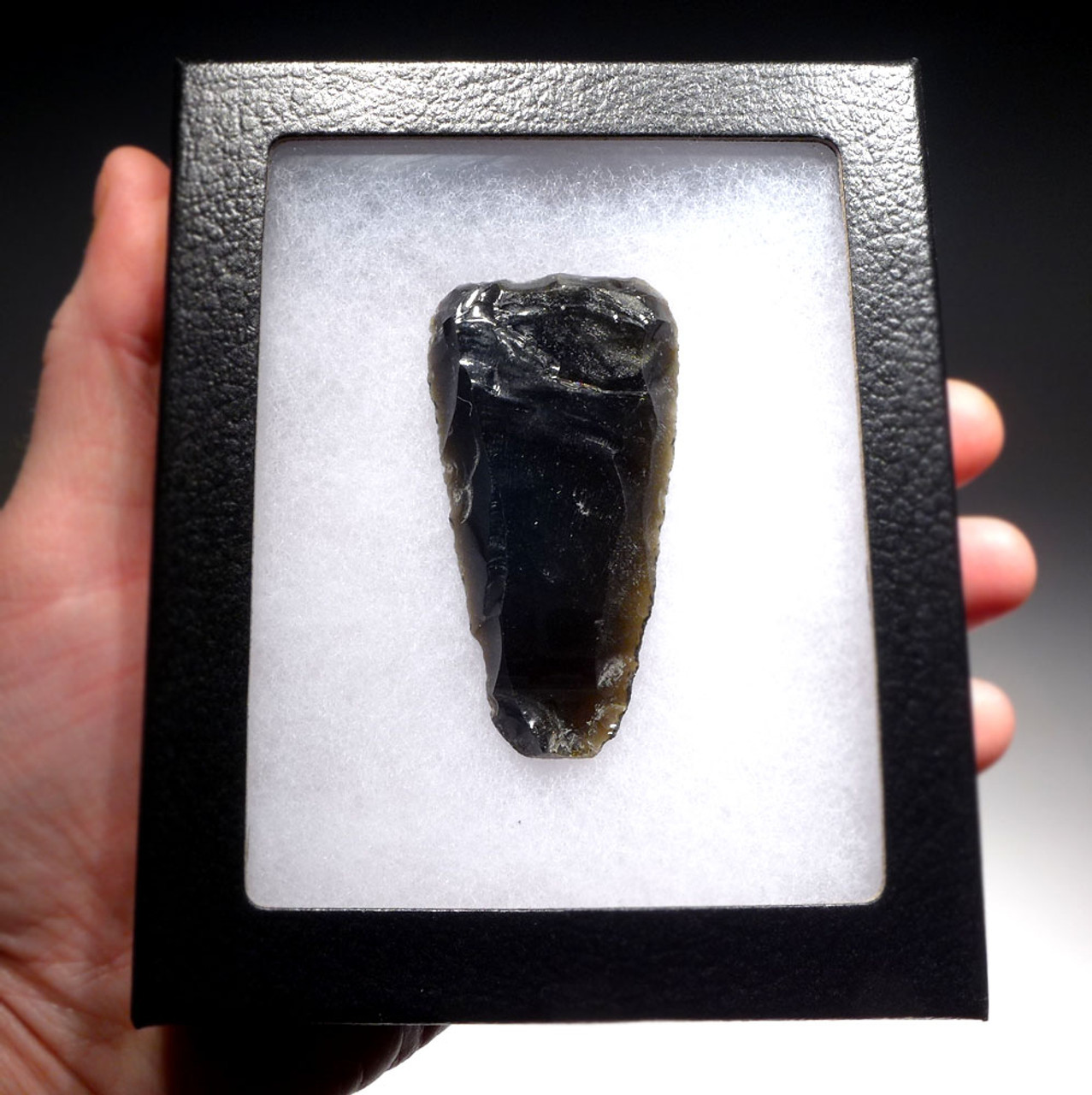Product Description
SEE MORE PRE-COLUMBIAN ARTIFACTS
With an incredible magical presence, this large ritual UNIFACIAL END SCRAPER of the Pre-Columbian Teotihuacan Empire is made from precious green sheen obsidian! It is no wonder that these ancient people believed this stone had its own spirit - when light hits the surface, the inside lights up and sparkles beyond description. The light effect in sheen obsidian is caused by internal linear bubbles that formed in the ancient volcanic glass before it hardened. While sheen obsidian occurs in black colors, rare green obsidian with this feature makes it especially scarce! No doubt this end scraper left its users with a sense of awe when originally used in ancient times. Even now, to see the effect of the stone in sunlight is something beyond words. Since green obsidian was an exclusive luxury reserved only for aristocracy and ceremonial purposes at this time, the purpose and ancient importance of this breath-taking artifact is obvious.
Mineral and sediment can be seen deep in flake scars which are indicators ONLY found in AUTHENTIC specimens such as this. Caution must be applied in acquiring ancient obsidian artifacts because the stone does not patinate on the surface like other lithic types.
Obsidian was prized by the ancient Pre-Columbian Indians and even today, it is still used in modern medicine for scalpel blades as obsidian can flake to an edge one molecule thick, thereby attaining a level of sharpness impossible to achieve with a steel scalpel. As a matter of fact, aside from using lasers in modern surgery, the preferred scalpel is one from obsidian. Because of its sharpness, obsidian leaves less of a scar and does less tissue damage than a scalpel or knife made of any other substance known to Man. Obsidian is 15 times sharper than surgical steel, It’s no wonder that obsidian became a valuable tool in medicine and warfare when you consider that at an obsidian scalpel can rival diamond in the fineness of its edge. Common household razor blades are 100 times thicker than obsidian!
HISTORY
In the first millennium A.D., the central American mega-city of Teotihuacan was THE largest city in the Pre-Columbian Americas. It had a broad influence on its neighboring cultures both, those in simultaneous existence, and others long after. At its peak in 450 A.D. with an estimated population exceeding 200,000, it was one of the largest cities in the world. The founders of this great city are a mystery and much debate has circled around who exactly built the city. Because the inhabitants seem to have been multi-ethnic (Nahua, Otomi, Totonac and Mayan) the culture is not attributed to a specific ethnicity or tribe but is called TEOTIHUACAN or TEOTIHUACANO.
Teotihuacan was an enormous industrial city and trading center housing a variety of trades and craftspeople. The quality of artistry in the thousands of mural paintings from Teotihuacan artists rivaled anything that was to be produced by many master painters of Renaissance Europe much later in time. Perhaps, the most famous industry the city was known for was its extensive production of obsidian objects. The processing of obsidian was the most developed art and the main source of wealth in Teotihuacan. The obsidian craftspeople made up at least 12% of the total population, according to reliable assessments of archeologists and the multitude of archeological findings. Teotihuacan workshops produced weapons, tools, figurines, jewelry and art objects of which were intended for commercial trade beyond the geographical boundaries of the city. About 25% of the obsidian industry was devoted to blade production including prismatic, core-struck blades. Large bifacial blades were for ritual use in human sacrifices where priests removed the heart from the slain victims.
Obsidian deposits in the Valley of Mexico, which fell under Teotihuacan control during the Early Classic Period, were Pachuca, Otumba, and Chicoloapan. Obsidian from Pachuca is notable because of its unique green-gold color and its internal purity which makes it one of the highest quality obsidian sources in Mesoamerica. It was much sought after and widely traded. Green obsidian is also found in the area of Tulancingo, but is distinct from Pachuca obsidian because of its internal opacity (e.g., it is a more milky or clouded green).
Many of the same gods worshipped by other pre-Columbian cultures of the surrounding region were worshipped by the inhabitants of Teotihuacan. Gods such as the Feathered Serpent and the rain god, were later worshipped by the Aztecs. It is believed the Mayans and later period Aztecs, along with many other tribes, were heavily influenced by Teotihuacan and like those cultures, human sacrifice was practiced in Teotihuacan. This is evidenced by numerous human skeletons showing signs of ritual sacrifice, excavated from the sites where the pyramids were built.
The end of Teotihuacan is as much a mystery as its beginning. Most recent studies now show the city's decline began some time around the 6th century A.D. and may have been caused not by a conquering neighbor, but by internal civil unrest and uprising.
 US DOLLAR
US DOLLAR
 EURO
EURO
 AUSTRALIAN DOLLAR
AUSTRALIAN DOLLAR
 CANADIAN DOLLAR
CANADIAN DOLLAR
 POUND STERLING
POUND STERLING






















